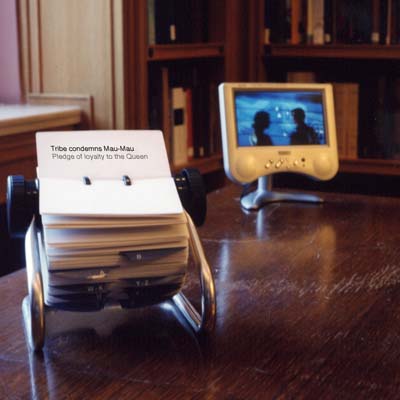

Fourplus : Writing DNA review by Alice Angus in MATTERS magazine issue 17
Celebrating the discovery of the double helix, Four Plus : Writing DNA at the Wellcome Trust, London includes new commissions by ten artists alongside the first public viewing of Francis Crick's archive. Taking place throughout public areas of the Wellcome Building, and online, one of the highlights of this exhibition is searching for the works that are secreted away in nooks and crannies of the library and reading room, finding curious books and unexpected discoveries along the way.
The commissioned artists focus on aspects of the four principal scientists involved in the discovery: James Watson, Francis Crick, Rosalind Franklin and Maurice Wilkins. The artists differ in their approach but all the works are linked by their journeys through libraries and archives, through time and across political and physical boundaries to explore the implications of scientific knowledge. [...]
The highlight of the show is Gair Dunlop's witty Twentieth Century Calling , in which he continues his exploration of 'the Industrial Sublime' setting the optimistic mid-20th century idea of scientific discovery against personal and social chronologies. Using a Rolodex card file, 1950s desk and a tiny TV screen showing footage from Century 21 Calling ( a Bell Laboratories promotional film shot at the 1962 Seattle World Fair bubbling over with happy clean optimism and neat colourful 50s clothes) he contrasts contemporary events, media stories and biographical fragments relating to Maurice Wilkins and his work on DNA.
 |
 |
The
Human
Factor
Visual art: Designer Bodies - Stills, Edinburgh, until June 6
Reviewed by Catriona Black
IT’S no use talking about the implications of genetic engineering as if
they’re all in the future; babies have already been born with added genes,
and others have been aborted because of defects as minor as a cleft lip. It’s
not even as if we’re on the margins of the debate, when Dolly the
sheep was made right here in Scotland.
Surely the day will come when scientists see themselves as artists, seeking
to create the perfect human being out of DNA, just as Michelangelo did
in marble. It’s one thing if they see themselves as classicists,
and quite another if they turn to Cubism. This is no laughing matter for
the four Scottish artists
at Stills, whose show Designer Bodies explores the past 50 years of DNA
research and its implications for those with inherited conditions.
The gallery space is put to good use, providing a reading station for each
artist and avoiding any sense of overcrowding. The works upstairs, by three
women artists,
present statistics with a personal touch, bringing empathy into the equation.
Downstairs Gair Dunlop’s video installation shows us how our brave
new world was imagined in the 1950s and 1960s.
Dunlop’s installation centres on archive footage of two gee-whiz kids running
around the 1962 Seattle World Fair in wide-eyed, technicoloured ecstasy. On the
other side of the darkened room, black and white archive footage tells you that
there’s “no limit except the imagination of men who do new things”,
a reminder of the naive optimism of those heady days.
Upstairs is a different story. Christine Borland’s two works are simple
in execution, but both have enormous impact. Home Testing comprises four old-
fashioned dice tables, with some simple instructions for each. On rolling the
dice, you are testing your chances of miscarrying, of succeeding at IVF, or of
conceiving a child with Down Syndrome or Spina Bifida. It’s a lot
more scarey when the numbers apply directly to you.
Nearby, Borland presents a sample of HeLa cells through a microscope. These
pretty purple cells are descended directly from those of a woman who died
in 1951. Henrietta
Lack’s cells – and those cultured from them – have been
sold widely for research ever since. As a result there are now thought
to be more
of her cells in the world than there were in her own body.
Just across from the dice tables, Jacqueline Donachie presents her small
book, DM, as a series of 25 digital prints. They tell the touching story
of how her
family found they had an inherited muscular disease. It’s told as a personal
journey, and accompanied by informal photographs of experts in the field. Just
as if they’d thrown a dice, Jacqueline didn’t inherit the disease,
but her sister did.
Gina Czarnecki’s ambitious interactive installation, Silvers Alter, dominates
the space, with its fluid display of naked adults, complete with genetic data
and personal comments for each. By stepping on pressure sensitive mats you can
select individuals, breed them with others and choose who should be saved from
an early death. Unfortunately, for some reason, I just couldn’t get
them to breed. Which takes us back to those dice.
Sunday Herald 02 May 2004